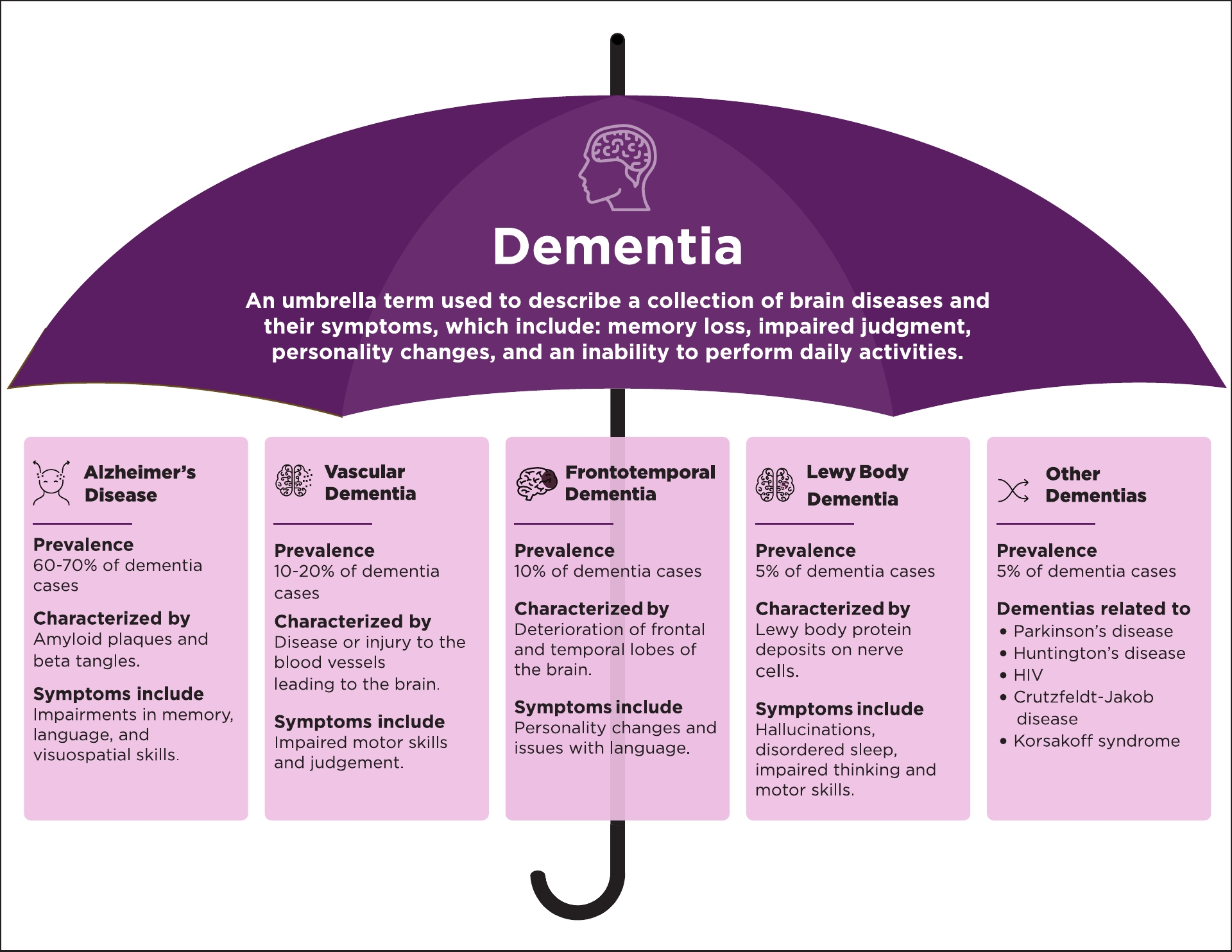Dementia is an umbrella term used to describe a condition that causes changes to a person’s memory, reasoning, and thinking. Alzheimer’s and dementia are often used interchangeably, and while related, they are different. There are various types of dementia, and each has unique causes and symptoms. Some people have more than one kind of dementia, and different types of dementia can have the same symptoms, making diagnosis difficult.
Currently, dementia affects 50 million people worldwide, and approximately five million are Americans. In Arizona alone, Alzheimer’s is the fifth leading cause of death.
Alzheimer’s Disease
The most common type of dementia, Alzheimer’s Disease, accounts for 60% to 80% of dementia cases. As of 2020, 5.8 million Americans were living with the disease, and many are residents of communities offering memory care services.
While some memory loss is associated with aging, Alzheimer’s is not a normal part of the process. It is a progressive brain disease that worsens over time. Alzheimer’s is most common in people 60 or older, but about 5% of cases are diagnosed in younger individuals.
Abnormal brain structures called tangles and plaques are associated with Alzheimer’s disease. Tangles consist of a twisted protein called tau that builds inside cells. Plaques are protein fragments that build up in spaces between nerve cells. Scientists believe that plaques and tangles damage and destroy nerve cells.
Those suffering from the disease may wander and get lost, be unable to recognize family or friends, and exhibit impulsive behavior. In the worst cases, they can no longer communicate. Those with advanced Alzheimer’s often move to a community with the resources to meet their needs.
Frontotemporal Dementia (FTD)
According to the National Institutes of Health (NIH), frontotemporal dementia occurs when TDP-43 proteins and tau are inside the brain’s frontal and temporal lobe neurons. An individual suffering from this condition often benefits from living in an assisted living residence with specially trained staff.
People with FTD may have impulsive behavior and problems planning and organizing. They might develop emotional flatness or be overly emotional. Symptoms also include difficulty balancing and walking and speech problems. Most people with the condition begin to exhibit symptoms between ages 45 and 64.
Vascular Dementia
People living with vascular dementia experience a decline in thinking skills due to decreased blood flow to the brain. Damage occurs because the brain is deprived of vital nutrients and oxygen. Vascular dementia symptoms may show up very quickly, such as during a stroke, which can block major blood vessels. The condition is the second most common cause of dementia, after Alzheimer’s.
Those with vascular dementia may forget current or past events and have trouble learning new information or following instructions. They frequently misplace things and show poor judgment. Some experience hallucinations or delusions. The condition is most common in seniors over 65.
Dementia with Lewy Bodies
Lewy body dementia is progressive dementia characterized by hallucinations and sleep problems. Per the Alzheimer’s Association, it is associated with damaged brain cells caused by a buildup of an alpha-nucleic protein.
The disease is most common in those who are 50 or over. Symptoms include illogical or disorganized ideas and the inability to concentrate. Lewy body dementia can also cause rigid muscles, reduced facial expressions, and poor coordination. Individuals with the disease often have insomnia and are sleepy during the day. They may experience hallucinations. People with the condition often live in assisted living communities where they are safe and can get needed help.
Mixed Dementia
Studies from autopsies show that most dementia sufferers who are 80 or older probably have more than one type of dementia, a condition known as mixed dementia. In these cases, autopsy results typically indicate the presence of Alzheimer’s neurodegenerative processes and vascular disease processes.
Other Reasons for Dementia Symptoms
Many conditions can cause dementia-like symptoms, and it takes a thorough medical evaluation to pinpoint the source of symptoms. There is no cure for most dementia diseases, but depending on the cause, some are reversible. For instance, Creutzfeldt-Jakob Disease and Huntington’s Disease can cause dementia symptoms. Other causes for symptoms include:
- Environmental Factors. Substance abuse, heavy-metal poisoning, anorexia, and lead poisoning may result in dementia-like symptoms.
- Infectious Diseases. Specifically, the human immunodeficiency virus can lead to HIV-associated dementia (HAD), resulting in dementia symptoms.
- Reversible Dementia. Some dementia linked to specific conditions may be reversed with treatment. For example, dementia caused by infections, metabolic disorders, nutritional deficiencies, and depression may be reversible.
Millions of people worldwide suffer from various types of dementia, which is most common among the elderly but can strike at a much younger age. Alzheimer’s is the most common type of dementia, and vascular dementia is the second. Dementia with Lewy bodies and frontotemporal dementia can produce similar symptoms. There is no dementia cure, and some forms are irreversible.
The Gardens of Sun City is an assisted living community in Sun City, Arizona, offering exceptional care for residents living with dementia. A skilled, caring staff helps residents live their best lives in a vibrant setting.

